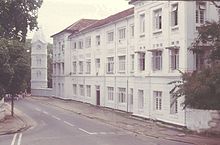Ceylon Medical College
 | |
| Type | Public |
|---|---|
| Active | 1 June 1870–1 July 1942 |
| Location | , , 06°55′08.30″N 79°52′16.30″E / 6.9189722°N 79.8711944°E |
| Campus | Urban campus |
Ceylon Medical College was a public medical school in Ceylon. The college was established in 1870 as the Colombo Medical School. The college was based in Colombo. The college was merged with Ceylon University College in 1942 to form the University of Ceylon. The medical college became the university's faculty of medicine. The college was also known as Colombo Medical College.[1][2]
History
The
The island was hit by the
The school benefited from large endowments, including land and buildings, provided by locals.[9][11] In 1875 Mudaliyar Samson Rajapakse gifted three and a half acres of land on which the school's successor, the Faculty of Medicine, University of Colombo, stands today.[6] The De Soysa Hospital/Lying-in-Home and the biology building was given to the school by Sir Charles Henry de Soysa.[6] In the same year his uncle Mudaliyar Susew de Soysa donated the school buildings which housed the colonial medical library, the pathology museum and the biological laboratory.[6] His son Mudaliyar J. W. C. de Soysa provided the funds to build the bacteriological institute in 1899.[6] Other benefactors included Muhandiram A. Simon Fernando Wijegooneratne and Vimala Gunawardane.[6]
The school's course length was extended to four years in 1873.[8] Loos left the school in 1875 after being appointed colonial surgeon for the Central Province.[6] He was replaced by Edwin Lawson Koch.[6] In 1876 the government started providing scholarships which provided free education at the school and post-graduate studies in Britain.[12] Koch died in 1877 and was replaced by Julian Louis Vanderstraatcn.[6] The school was renamed Ceylon Medical College in 1880.[13] The college's course length was extended to five years in 1884.[8]
On 29 December 1887 the school's LMS diploma was recognised by the
The college started admitting female students in 1892.[6][14] Allan Perry took over from Vanderstraatcn in 1898.[6] In 1905 two ordinances were passed relating to the college. The Council of the Ceylon Medical College was incorporated by Ordinance No. 3 1905.[5][12] Ordinance No. 5 1905 (Medical Registration Ordinance) allowed the Council of the Ceylon Medical College to register individuals (including holders of the Colombo LMS) allowed to practice medicine and surgery in Ceylon.[7][12]
The Ceylon University Ordinance No. 20 of 1942 established the University of Ceylon on 1 July 1942 by amalgamating Ceylon Medical College with Ceylon University College.[15][16][17] The medical college became the new university's faculty of medicine.[8]
Principals
| Principal | Took office | Left office |
|---|---|---|
| James Loos | 1870 | 1875 |
| Edwin Lawson Koch | 1875 | 1877 |
| Julian Louis Vanderstraatcn | 1878 | 1898 |
| Allan Perry | 1898 | 1915 |
| O. J. Rutherford | ||
| J. F. E. Bridger | ||
| J. F. L. Briereliffe | ||
| S. T. Gunasekera |
References
- ^ Mills, Lennox A. (1933). Ceylon Under British Rule (1795 - 1932). Oxford University Press. p. 262.
- ^ Wijesinghe, F. D. C. (12 July 2002). "Women in the medical profession". The Island (Sri Lanka).
- ^ a b c d Fonseka, Carlo. "Development of Health in Sri Lanka". Archived from the original on 2010-11-17.
- ISBN 81-206-1670-7.
- ^ a b c d e f g h i Arnold Wright, ed. (1999). Twentieth Century Impressions of Ceylon. Asian Educational Services. pp. 225–226.
- ^ a b c d e f g h i j k l m n "University History: A Glimpse into the History of the Oldest Medical School in Sri Lanka" (PDF). University of Colombo Newsletter. 1 (2). University of Colombo: 2. September 2008. Archived from the original (PDF) on 2012-08-04.
- ^ a b c d e f Samarasekera, Ananda (28 July 2003). "Sri Lanka Medical Council: Past, Present and the Future". The Island (Sri Lanka).
- ^ a b c d "History of the Faculty of Medicine". Faculty of Medicine, University of Colombo.
- ^ a b Arnold Wright, ed. (1999). Twentieth Century Impressions of Ceylon. Asian Educational Services. p. 76.
- ^ Arumugam, Thiru (14 March 2010). "The human drama underneath the factual medical, historical material". The Sunday Times (Sri Lanka).
- ISBN 81-206-0963-8.
- ^ ISBN 978-0-415-57543-0.
- ^ "About Us". Sri Lanka Medical Council.
- ^ .
- ^ Ratnapala, Noeline S. (1991). "Beginnings of University Education in Sri Lanka; in Retrospect" (PDF). Vidyodaya Journal of Social Science. 5 (1&2): 92.[permanent dead link]
- ^ Abeygunawardene, H. (23 December 2002). "University of Peradeniya - more open than usual". Daily News (Sri Lanka). Archived from the original on 27 May 2005.
- ^ Banduwardena, Rupa (9 October 2011). "University of Ceylon, Peradeniya – its glorious past". Sunday Observer (Sri Lanka). Archived from the original on 8 February 2013.
